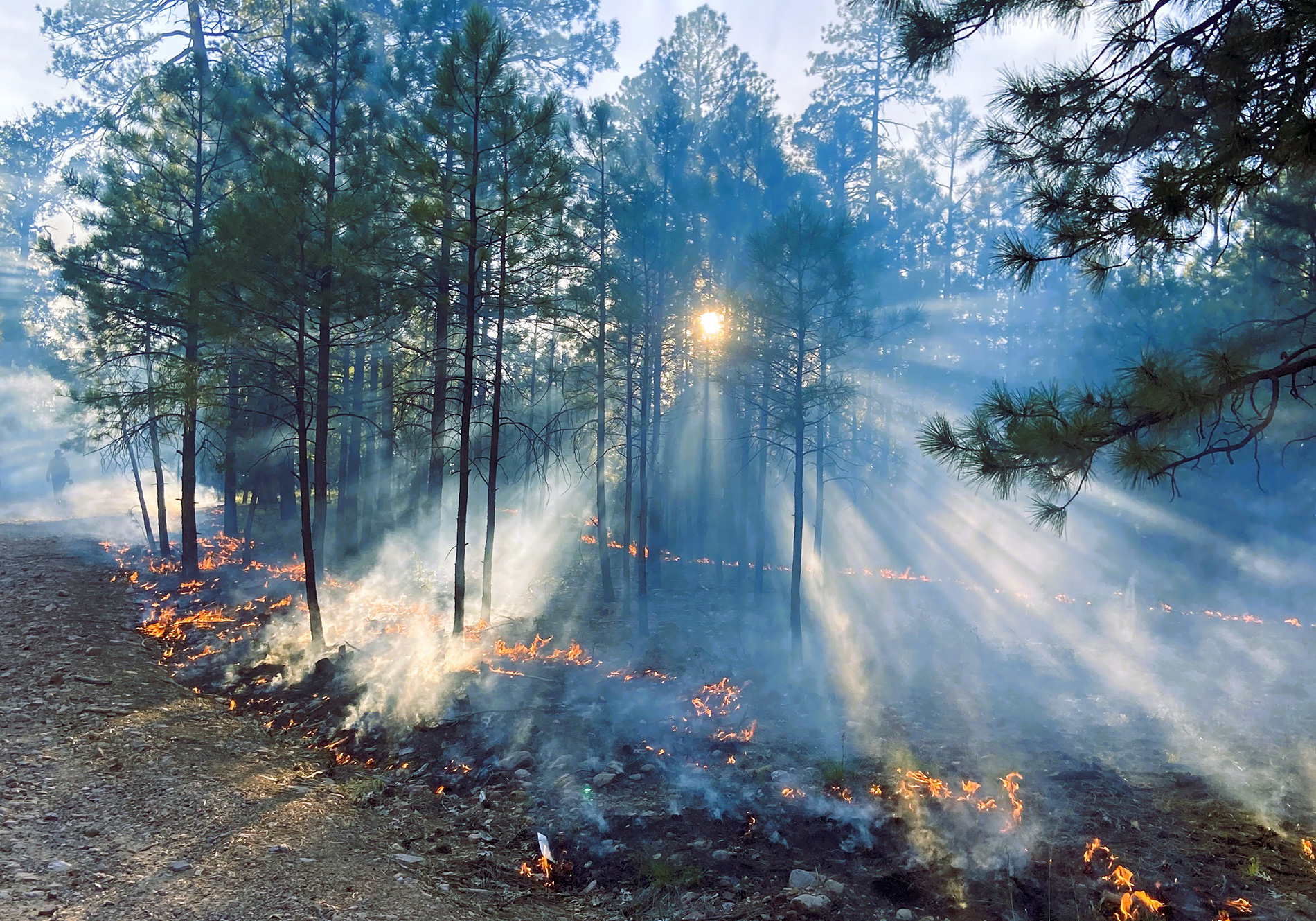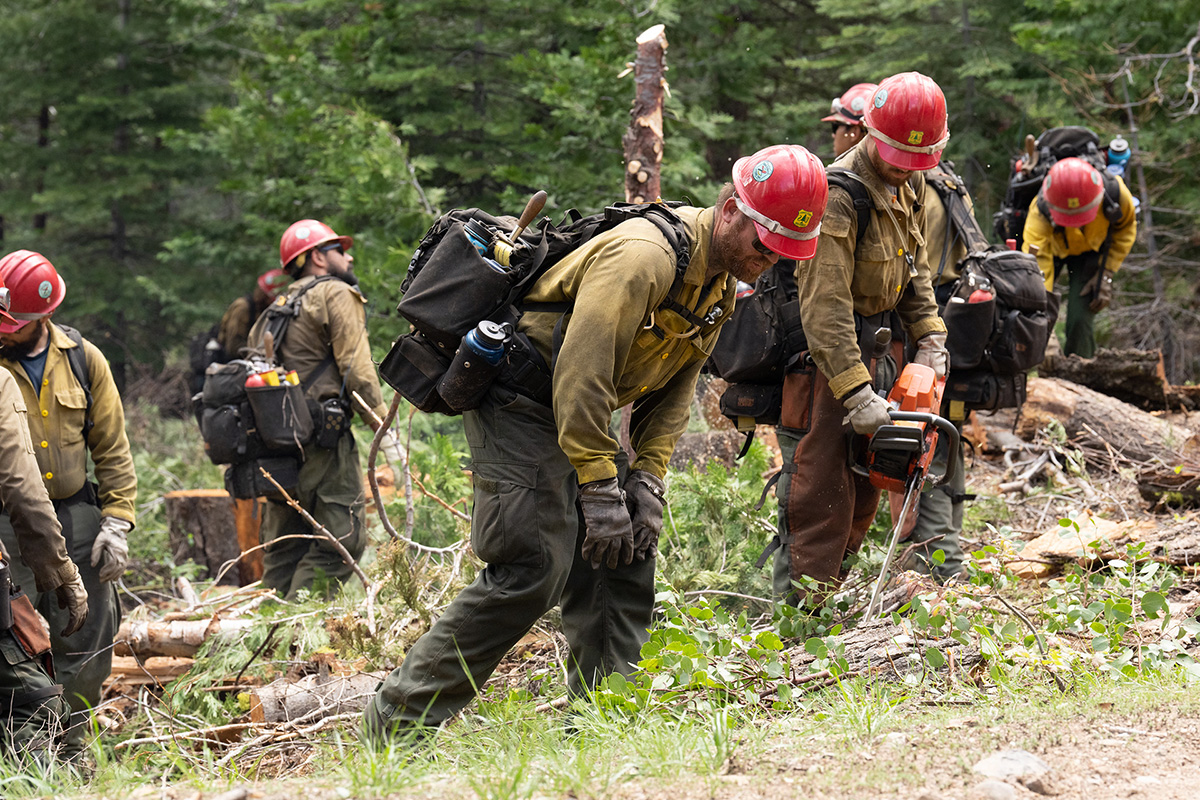
Smoke rising from a forest is ominous. Often it is the first alarm of another wildfire sparked by lightning or carelessness; a wildfire that potentially could become catastrophic and deadly.
On Aug. 16, 2023, the residents of Poderosa and Colcord Estates and neighboring towns on the Tonto National Forest Payson Ranger District felt that foreboding when they looked to the skies and saw rising smoke. That evening, smoke began wafting through ponderosa pine 11 miles northeast of Young, Arizona, and 27 miles east of Payson. The smoke’s source was the lightning-caused Valentine Fire.
The Valentine Fire burned in a location and under specific weather conditions that allowed fire managers an opportunity. Instead of rushing to suppress the fire, the Payson Ranger District personnel relied on their strong relationships with local communities and a solid plan to use the fire to lessen the intensity of future fires in the area.
Thus, the Forest Service’s Type 3 Incident Management Team and 150-plus responding firefighters devised a strategy to put the fire to work within the guidelines of the Land Management Plan.
“Fire managers follow a plan that specifies the response to fire to be taken in an area,” Daniel Whatley, Payson Ranger District Fire Management Officer said. “We implemented a ‘confine/contain’ strategy and reintroduced fire into an ecosystem devoid of fire for more than 50 years.”
Crews established fire breaks around approximately 10,000 acres and managed the Valentine Fire within that zone. Firefighters kept the fire away from high voltage transmission lines, State Routes 260 and 512, and nearby communities.
“Much of the acreage was upwind and downhill from communities,” Whatley said. “The fire’s location was a key factor in determining our strategy.”
When officials finally declared the Valentine Fire out on Dec. 1, 2023, it had covered 9,644 acres of ponderosa pine, hardwood leaf litter and timber. The price tag: $10 million. However, Whatley noted it would have taken the district between three and five years and cost about $50 million to achieve similar results using mechanical fuels treatments. The benefits from the Valentine Fire for future wildfire risk reduction are immediate.
Communication and trust
Payson District Ranger Matt Paciorek cited how years of Forest Service staff sharing consistent messages with partners, permittees, local law enforcement agencies and fire departments and the subsequent trust resulted in the complementary goals of restoring fire as a natural ecological process and reducing fuels to increase forest resilience within the area.
“Honest, transparent communication goes hand-in-hand with establishing trust,” Paciorek said. “When national forests achieve that trust with local communities it provides fire managers with more flexibility in their choice of firefighting strategies and residents with more certainty during the stressful events of wildfire.”
Over the course of the Valentine Fire, Forest Service personnel hosted four community meetings with assistance from Incident Management Teams and local law enforcement. Three meetings took place in Christopher Creek, Arizona, and one meeting occurred in Young, Arizona.
“During these meetings, our subject matter experts provided updates and answered questions from attendees about the fire,” Paciorek continued. “Public information officers created social media posts and distributed newsletters while news releases were posted on the Tonto website. Efficient communication continues to help the Forest Service build and strengthen relationships.”
Learning to live with fire
During the community meetings, Forest Service presentations included information about fire ecology, an ecological branch that focuses on the roles of wildland fire and its relationship to the environment that surrounds it, both living and non-living. It examines fire dependence and adaptation of plants and animals, fire history, fire regime and fire effects on ecosystems.
Mary Lata, a fire ecologist on the Tonto National Forest, attended two of the four meetings. Her briefing informed attendees about ignition density via pine needles, lightning strikes in the Payson area over a 50-year period and their impact, and the correlation between fires and dry thunderstorms in June and July that precedes Arizona’s monsoon season.
“I outlined why fire is a natural process and how fire often operates as an integral part of the ecosystem in which it occurs,” Lata said. “It’s important for residents living within or adjacent to a national forest to understand that wildfires have occurred in Arizona for centuries and will continue to happen.”
“We also continue to explain the benefits of fire to partners and communities,” she said. “After decades of fire exclusion, an ecosystem that needs periodic fire becomes unhealthy. Trees are stressed by overcrowding; fire-dependent species disappear; and flammable fuels build up and become hazardous.”
The right fire at the right place at the right time protects residential areas from extreme fires while also protecting local ecosystems.
“It recycles nutrients back into the soil, removes unwanted species that threaten native species in an ecosystem, minimizes the spread of pest insects and disease, and promotes the growth of trees, wildflowers, and other plants,” Lata said. “Fire can be good for people and the land.”

Sense of community
Ansgar Mitchell was a Valentine Fire public information officer (PIO) and worked the fire for nearly its entirety. When he’s not working as a PIO, he’s an Assistant Fire Management Officer in Fire Prevention on the Prescott National Forest. His work is devoted to building community engagement and educating about fire safety. The successes he saw emerge from the events of the Valentine Fire were not only land management based but “a true sense of community through adversity.”
“It got neighbors who never met each other to form a communication link, that has created a neighborhood awareness for not just fire emergencies but for events that impact everyone,” said Mitchell. “And—it is still used today.”
President Darin Palmer of Christopher Creek’s Church of Jesus Christ of Latter-Day Saints made space in their building to host Forest Service community meetings. And what Palmer observed from the Forest Service and community interaction was a cohesively stronger community.
“A big part of our sense of community began to increase in these meetings held by the Forest Service,” said Palmer. “It gave us an opportunity to get to know one another better, to share what we learned, and it gave us opportunities to be better neighbors. We started to have an increase in person-to-person communications and friendships.”
The Valentine Fire wasn’t just a successfully managed fire that saved money, or managed the land, it brought people together and made community ties stronger.
“These may seem like small blessings to our community,” said Palmer. “But for us who live here, they were wondrous.”







